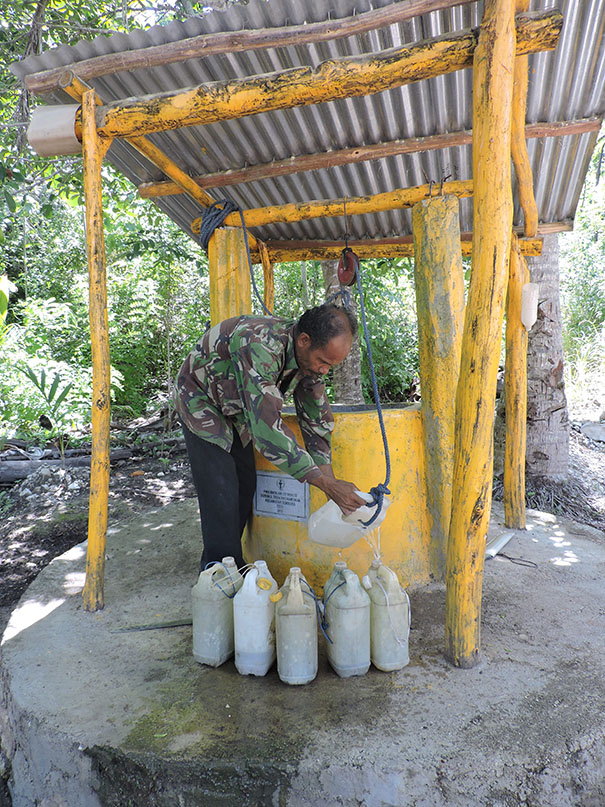Stories of Change

Yusuf Tenis at his community's protected well. Photo: CWS
In Enonabuasa village, 90 percent of families can now use an improved water source, compared to 49 percent a year earlier.
Protected wells, healthier families
Mr. Yusuf Tenis, his wife and four children live in Fatutek hamlet on Timor island at the end of the Indonesian archipelago. The only water source for Yusuf’s family, 32 other families and, in the long dry season, their livestock too, used to be a one-meter deep hole in the ground that regularly filled up with dirt, leaves and animal waste. This was the community water source for all uses: drinking, cooking, washing dishes and clothes and bathing.
Not surprising, the Tenis children and most other children and many adults in Fatutek suffered from frequent diarrhea and skin conditions caused by dirty water.
As community partners in the Timor Zero Hunger initiative, with support from CWS members and our key funding partner, UMCOR, Yusuf joined others from Fatutek to build a protected well: several concrete rings stacked on top of each other as a casing raised the well above ground level, and a simple roof stops bird and animal waste, and leaves and loose dirt, from contaminating the water.
From this improved water source the Tenis family and another 150 villagers now have access to better quality drinking water as well as clean water for their homes and personal hygiene.
Diarrhea and skin infections among children have lessened, and there is now enough water for Mr. Tenis and his family to have a home garden, where they grow nutritious vegetables to improve their diets and wellbeing.
About the Program
In Enonabuasa village on Timor island at the remote southeast end of the Indonesian archipelago, access to water is difficult, particularly during the long dry season from May to October. Often people rely on rivers, unprotected wells and other unsafe sources for water to drink, cook with and otherwise supply their homes and gardens. The strong 2015-2016 El Nino is making the current dry season particularly long, exacerbating the situation.
To help people better meet their needs for safe water, a CWS water project was started in Enonabuasa through community-led mobilization, which started with water resource mapping. Focus group discussions with women and men considered the types and conditions of existing water resources and the technical feasibility of different safe water infrastructures, and then they agreed on priority needs and solution.
The preferred solution was for cement lined, raised wells that are protected from runoff water and covered so bird and animal waste cannot contaminate the water, and animals themselves cannot fall into the wells. Another agreed solution was for protected springs that shield running water from runoff and other contamination with a brick, stone or concrete ‘spring box’ at the water source so it flows directly out of the box and into a pipe or cistern, without being exposed to contaminants.
Once solutions were agreed upon, community members formed teams for planning, construction and monitoring/maintenance, and then everyone joined information and education/training sessions to support high quality building, ongoing operation and maintenance for the improved water sources. In addition to providing information and training, CWS supplied materials not locally available, like PVC pipe, while community members contributed most materials, including rock and sand, and their labor.
In 2015 with technical support and advice from CWS field staff made possible by our funding partnership with UMCOR, the people of Enonabuasa formed six water committees to ensure operation and maintenance of water supply facilities; identified eight springs and six wells to be protected and improved; dug six new protected wells and built other small-scale infrastructure, such as cisterns and public taps, for eight springs. Now, 90 percent of the village’s 224 households (1,000-plus people) can use an improved water source [as defined by the WHO/UNICEF], compared to just 49 percent a year earlier. And, like the Tenis family in Fatutek hamlet, many families have a healthier home.
